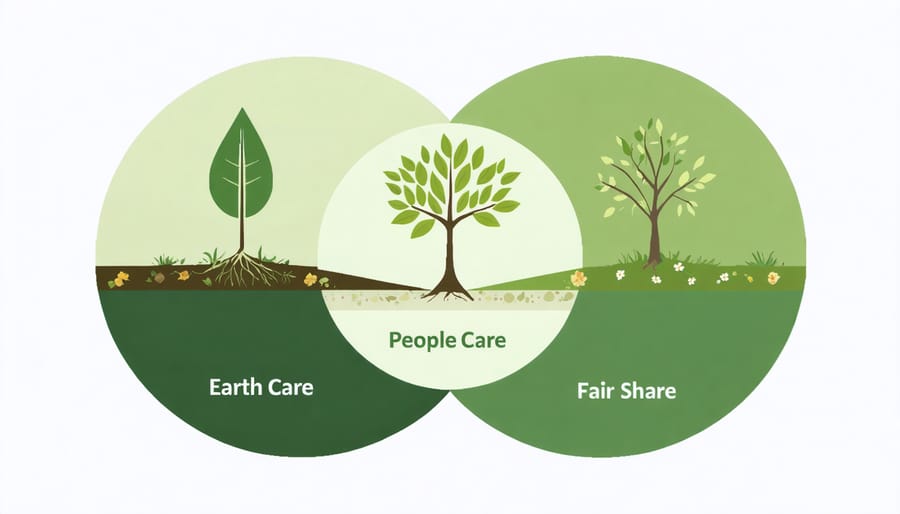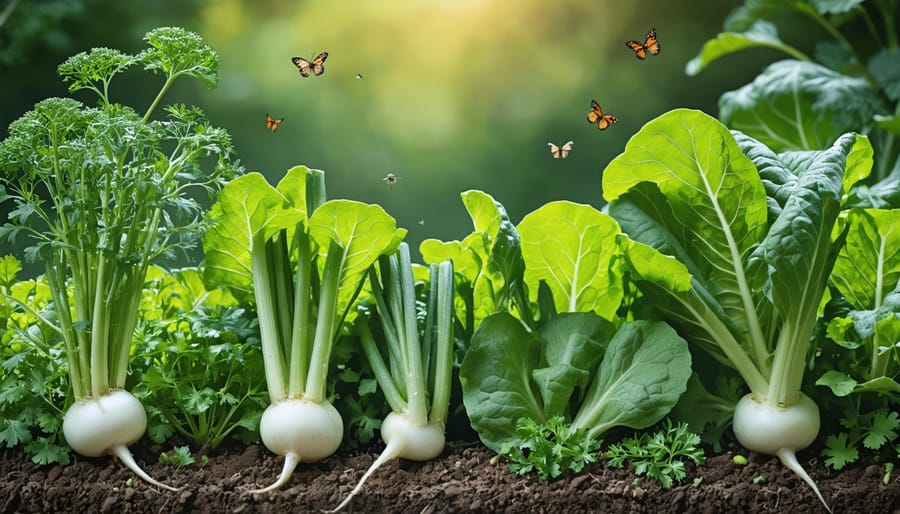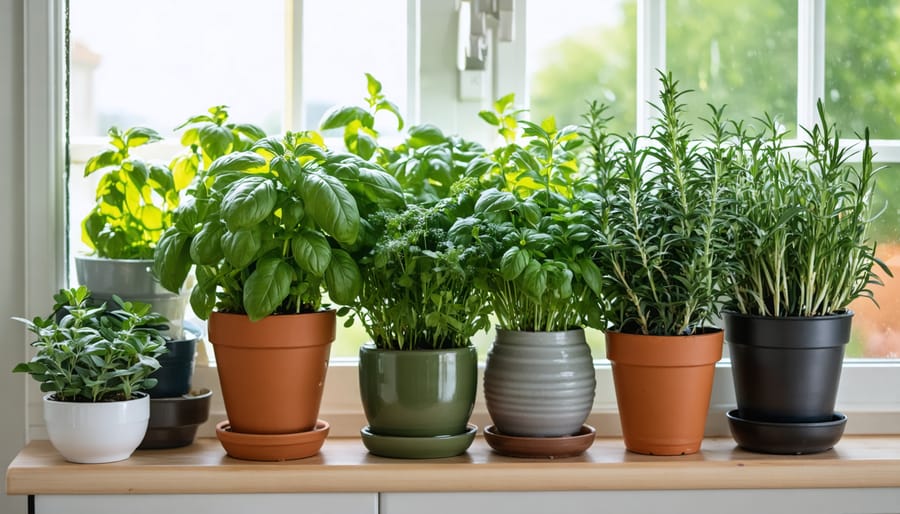Imagine a garden that works with nature instead of against it, where every plant, insect, and microorganism plays a vital role in creating a thriving ecosystem. That’s permaculture gardening – a revolutionary approach to growing food and creating sustainable landscapes that mimics natural patterns and relationships found in the wild. Unlike traditional gardening methods that often fight against natural processes, permaculture designs intelligent systems that practically maintain themselves, producing abundant harvests while actually improving the environment.
Born from the minds of Bill Mollison and David Holmgren in the 1970s, permaculture combines the words “permanent” and “agriculture,” though it’s evolved to encompass much more than just growing food. It’s a holistic design philosophy that transforms ordinary gardens into self-sustaining ecosystems where waste becomes a resource, problems become solutions, and every element serves multiple purposes.
What makes permaculture truly remarkable is its practical approach to sustainability. By understanding and applying natural patterns – like how forest layers work together or how water flows through a landscape – gardeners can create productive spaces that require less work over time while yielding more food, beauty, and biodiversity than conventional gardens.
The Core Principles of Permaculture Gardening

Earth Care, People Care, and Fair Share
At the heart of permaculture gardening lie three core ethical principles that guide every decision and action: Earth Care, People Care, and Fair Share. These principles work together to create a harmonious and sustainable system that benefits both the environment and its inhabitants.
Earth Care emphasizes our responsibility to protect and nurture the natural world. This means working with nature rather than against it, protecting soil health, conserving water, and promoting biodiversity. When we care for the Earth, we ensure that our gardens contribute positively to the local ecosystem rather than depleting it.
People Care focuses on meeting human needs sustainably while building community. This principle recognizes that healthy communities are essential for sustainable living. In practice, this might mean sharing garden knowledge with neighbors, growing nutritious food for your family, or creating spaces where people can connect with nature and each other.
Fair Share, also known as “Return of Surplus,” encourages us to take only what we need and share the abundance. This could mean composting garden waste to return nutrients to the soil, sharing excess produce with neighbors, or saving seeds for future seasons. It’s about finding the right balance between growth and giving back.
These principles aren’t just abstract concepts – they’re practical guidelines that help us create productive, sustainable gardens that benefit everyone involved. By keeping these ethics in mind, permaculture gardeners can make decisions that support both immediate needs and long-term sustainability.
Working With Nature, Not Against It
At the heart of permaculture lies a simple yet powerful principle: working in harmony with nature rather than trying to control it. This approach mirrors the way natural ecosystems function, where every element plays a vital role in supporting the whole system. Just as you might find layers of vegetation in a forest – from tall trees to ground covers – permaculture gardens incorporate these same patterns to create thriving, self-sustaining spaces.
By observing how plants naturally grow together in the wild, we can create what permaculture experts call “guilds” – groups of compatible plants that support each other’s growth. For example, tall sunflowers might provide shade for heat-sensitive lettuce, while shallow-rooted herbs protect the soil around deep-rooted fruit trees. This mimicry of natural systems can even extend to creating a complete food forest design principles in your own backyard.
Nature doesn’t create rows of single crops or bare soil – instead, it fills every available niche with life. In your permaculture garden, this might mean planting climbing beans that use corn stalks for support, while squash spreads below to shade the soil. This traditional Native American “Three Sisters” planting method is a perfect example of natural ecosystem mimicry at work.
Remember, in nature, there’s no such thing as waste – fallen leaves become mulch, dead plants feed the soil, and insects help with both pollination and pest control. By embracing these natural cycles, your garden becomes more resilient and requires less intervention over time.
Key Elements of a Permaculture Garden
Zones and Sectors
In permaculture gardening, the way you organize your garden zones can make a huge difference in your daily gardening routine. Think of your space as a series of concentric circles, with each zone serving a specific purpose based on how frequently you need to access it.
Zone 1 is your most visited area, typically right outside your back door. This is where you’ll want to place herbs, salad greens, and frequently harvested vegetables that you use daily in your cooking. Zone 2 might include your main vegetable beds, small fruit trees, and compost bins – areas you visit several times a week.
As you move outward, Zone 3 is perfect for larger crops, fruit trees, and berry bushes that need less frequent attention. Zone 4 could be a semi-wild area for foraging and collecting natural materials, while Zone 5 is left completely natural, serving as a wildlife haven and observation area.
Within each zone, you can create sectors that account for natural elements like sunlight, wind patterns, and water flow. For instance, you might position taller plants to create windbreaks or shade-loving plants in areas naturally shadowed by structures. This thoughtful arrangement helps create a harmonious, self-sustaining garden that works with nature rather than against it.

Plant Guilds and Companions
Plant guilds are one of the most fascinating aspects of permaculture gardening, where plants are grouped together to create mutually beneficial relationships. Think of it as creating a plant community where each member supports the others, just like good neighbors helping each other out!
A classic example is the Native American “Three Sisters” guild, combining corn, beans, and squash. The corn provides a natural trellis for the beans to climb, while the beans fix nitrogen in the soil to feed the corn and squash. The squash spreads along the ground, creating living mulch that retains moisture and suppresses weeds.
When planning your plant guilds, consider these beneficial combinations:
– Herbs like basil and oregano planted near tomatoes to enhance flavor and repel pests
– Marigolds scattered throughout the garden to deter harmful insects
– Comfrey as a nutrient accumulator, drawing minerals from deep in the soil
– Nasturtiums as sacrificial plants that attract aphids away from your vegetables
The key is to observe how plants interact and support each other. Some provide shade, others attract beneficial insects, and some improve soil quality. By creating these thoughtful combinations, you’ll build a resilient garden ecosystem that practically takes care of itself.
Remember that successful plant guilds often mimic natural forest layers, from tall trees down to ground covers, creating a complete and interconnected growing system.

Water Management and Conservation
Water management lies at the heart of successful permaculture gardening, focusing on using this precious resource wisely and sustainably. The key is to mimic nature’s water cycles while maximizing efficiency in your garden.
One of the fundamental practices is capturing and storing rainwater through rain barrels, swales, and rain gardens. These natural collection systems help retain water during wet periods for use during drier times. You can also incorporate mulching techniques, which help retain soil moisture and reduce evaporation, keeping your plants hydrated for longer periods.
Creating efficient water management systems doesn’t have to be complicated. Start by grouping plants with similar water needs together, a practice known as hydrozoning. This smart placement ensures you’re not over-watering some plants while under-watering others.
Consider implementing water-wise techniques like drip irrigation, which delivers water directly to plant roots, reducing waste through evaporation. Morning watering sessions are best, as they give plants time to absorb moisture before the heat of the day sets in.
Remember to work with your landscape’s natural contours. Gentle slopes can direct water flow to where it’s needed most, while terracing helps prevent erosion and maintains soil moisture on steeper terrain. These thoughtful approaches to water management create a more resilient and sustainable garden ecosystem.
Getting Started with Permaculture
Site Assessment and Planning
Before starting your permaculture garden, taking time to assess and plan your space is crucial for success. Begin by observing your garden throughout different seasons, noting how sunlight moves across your property, where water naturally collects, and which areas receive the most wind.
Make a simple map of your space, marking existing features like trees, structures, and slopes. Pay attention to your soil type by performing basic soil tests to determine its composition and pH levels. Understanding these elements helps you work with nature rather than against it.
Consider your local climate zone and typical weather patterns. This information will guide your plant choices and help you create microclimates that protect sensitive plants. Look for natural patterns in your landscape that you can incorporate into your design.
Think about your goals and daily routines. Where do you spend most of your time outdoors? This helps determine the best locations for frequently harvested plants versus those requiring less maintenance. Consider creating zones, with the most frequently visited areas (like herb gardens) closest to your house.
Don’t forget to account for future growth and changes. Leave space for plants to mature and plan for potential expansions. Remember, good permaculture design starts with careful observation and thoughtful planning, setting you up for a thriving, sustainable garden that works in harmony with nature.
Building Healthy Soil
At the heart of permaculture gardening lies the foundation of healthy, living soil. Think of soil as a thriving ecosystem rather than just dirt – it’s home to billions of beneficial microorganisms, fungi, and earthworms that work together to create the perfect growing environment for your plants.
The key to building healthy garden beds starts with the “no-dig” approach. Instead of tilling, which disrupts soil structure and beneficial organisms, layer organic materials on top of your existing soil. This mimics nature’s way of building fertility from the ground up.
Start by adding a diverse mix of organic matter: fallen leaves, grass clippings, kitchen scraps, and aged compost. These materials break down gradually, feeding soil life and releasing nutrients slowly over time. Mulching is another essential practice – a 2-3 inch layer of straw, wood chips, or leaves helps retain moisture, suppress weeds, and protect soil organisms.
Consider planting “green manure” crops like clover or vetch between growing seasons. These cover crops naturally add nitrogen to the soil, prevent erosion, and create habitat for beneficial insects. When ready to plant, simply cut them down and let them decompose right in place, adding more organic matter to your garden’s soil web.
Remember, healthy soil means healthy plants, and healthy plants mean less work for you in the long run!
Choosing Your First Plants
When starting your permaculture garden, it’s best to begin with hardy, easy-to-grow plants that provide quick rewards. Herbs like mint, rosemary, and thyme are excellent choices as they’re resilient and offer immediate value to your kitchen. These plants also attract beneficial insects, contributing to your garden’s ecosystem.
Consider starting with “companion plants” that work well together. For example, tomatoes and basil not only make a delicious culinary combination but also support each other’s growth. Marigolds are another beginner-friendly choice, as they naturally deter pests while adding cheerful color to your garden.
Leafy greens like Swiss chard and kale are fantastic starter plants because they’re relatively low-maintenance and can be harvested continuously throughout the season. Bush beans are also worth considering as they fix nitrogen in the soil, improving its quality for future plantings.
For fruit options, strawberries make an excellent ground cover and provide delicious harvests. They spread naturally and come back year after year, embodying the permaculture principle of sustainable growth.
Remember to choose plants that suit your local climate and available space. Starting small with just a few varieties allows you to learn each plant’s needs and behaviors without feeling overwhelmed. As your confidence grows, you can gradually expand your garden with more diverse species.
Embarking on your permaculture journey is one of the most rewarding decisions you can make for your garden, your community, and our planet. By embracing permaculture principles, you’re not just creating a sustainable food source; you’re becoming part of a global movement toward a more harmonious relationship with nature.
The benefits of permaculture gardening are truly transformative. From reducing water consumption and eliminating the need for harmful chemicals to creating thriving ecosystems that support local wildlife, every small step you take makes a meaningful impact. You’ll save money on groceries, enjoy fresher and healthier produce, and experience the joy of working with nature rather than against it.
Remember, permaculture isn’t about achieving perfection overnight. Start small, perhaps with a herb spiral or a simple composting system, and gradually expand your garden as your confidence grows. Learn from your successes and challenges, connect with other permaculture enthusiasts in your area, and celebrate each milestone along the way.
Whether you have acres of land or just a small balcony, there’s always room for permaculture principles in your life. The journey begins with a single seed, and the possibilities are endless. Take that first step today – your future self, your community, and our planet will thank you for it.
Ready to start? Pick one permaculture technique that resonates with you and implement it this weekend. You’ll be amazed at how quickly your garden transforms into a thriving, sustainable ecosystem.




